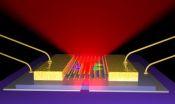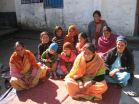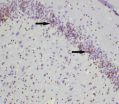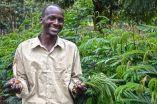(Press-News.org) Most modern electronics, from flat-screen TVs and smartphones to wearable technologies and computer monitors, use tiny light-emitting diodes, or LEDs. These LEDs are based off of semiconductors that emit light with the movement of electrons. As devices get smaller and faster, there is more demand for such semiconductors that are tinier, stronger and more energy efficient.
University of Washington scientists have built the thinnest-known LED that can be used as a source of light energy in electronics. The LED is based off of two-dimensional, flexible semiconductors, making it possible to stack or use in much smaller and more diverse applications than current technology allows.
"We are able to make the thinnest-possible LEDs, only three atoms thick yet mechanically strong. Such thin and foldable LEDs are critical for future portable and integrated electronic devices," said Xiaodong Xu, a UW assistant professor in materials science and engineering and in physics.
Xu along with Jason Ross, a UW materials science and engineering graduate student, co-authored a paper about this technology that appeared online March 9 in Nature Nanotechnology.
Most consumer electronics use three-dimensional LEDs, but these are 10 to 20 times thicker than the LEDs being developed by the UW.
"These are 10,000 times smaller than the thickness of a human hair, yet the light they emit can be seen by standard measurement equipment," Ross said. "This is a huge leap of miniaturization of technology, and because it's a semiconductor, you can do almost everything with it that is possible with existing, three-dimensional silicon technologies," Ross said.
The UW's LED is made from flat sheets of the molecular semiconductor known as tungsten diselenide, a member of a group of two-dimensional materials that have been recently identified as the thinnest-known semiconductors. Researchers use regular adhesive tape to extract a single sheet of this material from thick, layered pieces in a method inspired by the 2010 Nobel Prize in Physics awarded to the University of Manchester for isolating one-atom-thick flakes of carbon, called graphene, from a piece of graphite.
In addition to light-emitting applications, this technology could open doors for using light as interconnects to run nano-scale computer chips instead of standard devices that operate off the movement of electrons, or electricity. The latter process creates a lot of heat and wastes power, whereas sending light through a chip to achieve the same purpose would be highly efficient.
"A promising solution is to replace the electrical interconnect with optical ones, which will maintain the high bandwidth but consume less energy," Xu said. "Our work makes it possible to make highly integrated and energy-efficient devices in areas such as lighting, optical communication and nano lasers."
The research team is working on more efficient ways to create these thin LEDs and looking at what happens when two-dimensional materials are stacked in different ways. Additionally, these materials have been shown to react with polarized light in new ways that no other materials can, and researchers also will continue to pursue those applications.
INFORMATION:
Co-authors are Aaron Jones and David Cobden of the UW; Philip Klement of Justus Liebig University in Germany; Nirmal Ghimire, Jiaqiang Yan and D.G. Mandrus of the University of Tennessee and Oak Ridge National Laboratory; Takashi Taniguchi, Kenji Watanabe and Kenji Kitamura of the National Institute for Materials Science in Japan; and Wang Yao of the University of Hong Kong.
The research is funded by the U.S. Department of Energy, Office of Science, the Research Grant Council of Hong Kong, the University Grant Committee of Hong Kong and the Croucher Foundation. Ross is supported by a National Science Foundation graduate fellowship.
For more information, contact Ross at jasonsr@uw.edu or 206-543-2887 and Xu at xuxd@uw.edu or 206-543-8444.
Grant numbers: U.S. Department of Energy, Basic Energy Sciences, Materials Sciences and Engineering Division (DE-SC0008145); Research Grant Council of Hong Kong (HKU705513P); University Grant Committee (AoE/P-04/08).
Posted with photos: http://www.washington.edu/news/2014/03/10/scientists-build-thinnest-possible-leds-to-be-stronger-more-energy-efficient/
Scientists build thinnest-possible LEDs to be stronger, more energy efficient
2014-03-10
ELSE PRESS RELEASES FROM THIS DATE:
A signal to spread: Wistar scientists identify potent driver of metastasis
2014-03-10
An international team of researchers led by scientists at The Wistar Institute have discovered and defined LIMD2, a protein that can drive metastasis, the process where tumors spread throughout the body.
Their study, published in the March issue of the journal Cancer Research, defines the structure of LIMD2 and correlates the protein in metastatic bladder, melanoma, breast, and thyroid tumors. Wistar scientists have also developed and patented a monoclonal antibody that may one day be used as a prognostic test to see if tumors have LIMD2, and plans are underway to create ...
Malnourished children are better fed when mothers have network of peers
2014-03-10
URBANA, Ill. – Women in rural India who participate in a vocational training program learn more than just life skills. A recent University of Illinois study found that mothers who participated in a program designed to educate and empower women gained a network of peers that led to increased bargaining strength in the home, and significantly improved their children's consumption of rice and dairy.
"Prior to participating in Mahila Samakhya, which loosely translates to women of equal value, most of the participants reported regularly communicating with fewer than five ...
New research shows elevated mercury from in-ground wastewater disposal
2014-03-10
As towns across Cape Cod struggle with problems stemming from septic systems, a recent study by a Woods Hole Oceanographic Institution (WHOI) scientist focuses on one specific toxic by-product: mercury. In a study of local groundwater, biogeochemist Carl Lamborg found microbial action on wastewater transforms it into more mobile, more toxic forms of the element.
His findings were published in Environmental Science and Technology in November 2013.
Mercury (Hg) is a toxic trace metal. Wastewater contains small amounts of it, but Lamborg found the chemical processes that ...
What's new in autism spectrum disorder? Harvard Review of Psychiatry presents research update
2014-03-10
Philadelphia, Pa. (March 10, 2014) – Recent years have seen exciting progress in key areas of research on autism spectrum disorders (ASD): from possible genetic causes, to effective treatments for common symptoms and clinical problems, to promoting success for young people with ASD entering college. Updates on these and other advances in ASD research are presented in the March special issue of Harvard Review of Psychiatry. The journal is published by Lippincott Williams & Wilkins, a part of Wolters Kluwer Health.
"Autism is one of the most challenging disorders to ...
Phosphorylation of tau protein in rats subjected to cerebral ischemia-reperfusion injury
2014-03-10
Transient brain ischemia has been shown to induce hyperphosphorylation of the microtu-bule-associated protein tau. To further determine the mechanisms underlying these processes, Dr, Bo Song and co-workers from School of Life Sciences, Tsinghua University in China found for the first time that the interaction of tau with glycogen synthase kinase (GSK)-3β and protein phosphatase 2A is altered during transient brain ischemia. In addition, the researchers found that the neuroprotective function of lithium chloride may depend partly on the altered phosphorylation of tau, ...
Pretreatment with SSTF prevents hippocampal neuronal apoptosis due to cerebral infarction
2014-03-10
Focal cerebral ischemia-reperfusion may lead to neuronal loss in the hippocampus, which is regarded as one of the basic pathological mechanisms underlying cognitive impairment. The neuronal apoptosis plays an important role in cerebral infarction, determining the number of loss of neurons and infarct volume. Growing evidence has suggested that Chinese herbs can inhibit hippocampal apoptosis caused by ischemia-reperfusion. Prof. Shumin Zhao and team from Chengde Medical College in China pretreated rats with scutellaria baicalensis stem-leaf total flavonoid (SSTF) intragastrically ...
Agroforestry can ensure food security and mitigate the effects of climate change in Africa
2014-03-10
Agroforestry can help to achieve climate change mitigation and adaptation while at the same time providing livelihoods for poor smallholder farmers in Africa.
Scientists at the World Agroforestry Centre (ICRAF) say agroforestry - which is an integrated land use management technique that incorporates trees and shrubs with crops and livestock on farms - could be a win-win solution to the seemingly difficult choice between reforestation and agricultural land use, because it increases the storage of carbon and may also enhance agricultural productivity.
In a special issue ...
Smokers' brains biased against negative images of smoking
2014-03-10
This news release is available in French. What if the use of a product influenced your perception of it, making you even more susceptible to its positive aspects and altering your understanding of its drawbacks? This is precisely what happens with cigarettes in chronic smokers, according to a recent study by the Institut universitaire en santé mentale de Montréal and Université de Montréal.
The study showed that chronic smokers have altered emotional reactions when they are exposed to negative and positive images associated with tobacco. "We observed a bias depending ...
All paths lead to Rome, even the path to condensed matter theory
2014-03-10
Italian physicist Carlo Di Castro, professor emeritus at the University of Rome Sapienza, Italy, shares his recollections of how theoretical condensed matter physics developed in Rome, starting in the 1960s. Luisa Bonolis, a researcher at the Max Planck Institute for the History of Science in Berlin, Germany, invited Di Castro to reflect upon his research career, which he did in an interview published in EPJ H.
In this unique document, Di Castro talks about his upbringing during the second World War. He also explains how this childhood experience later influenced his ...
Two-dimensional material shows promise for optoelectronics
2014-03-10
A team of MIT researchers has used a novel material that's just a few atoms thick to create devices that can harness or emit light. This proof-of-concept could lead to ultrathin, lightweight, and flexible photovoltaic cells, light emitting diodes (LEDs), and other optoelectronic devices, they say.
Their report is one of three papers by different groups describing similar results with this material, published in the March 9 issue of Nature Nanotechnology. The MIT research was carried out by Pablo Jarillo-Herrero, the Mitsui Career Development Associate Professor of Physics, ...




